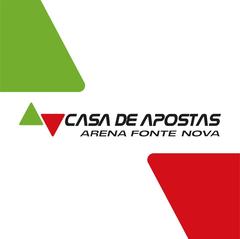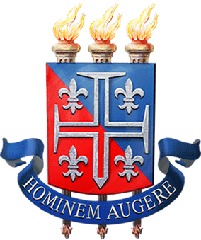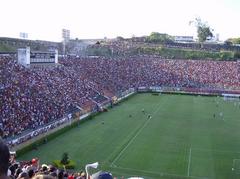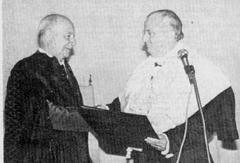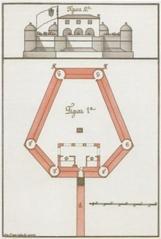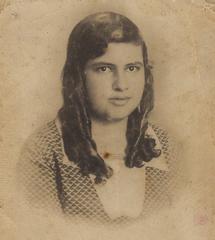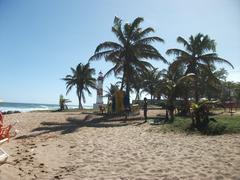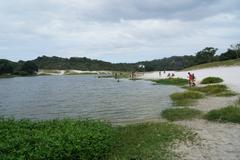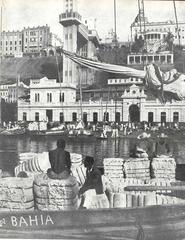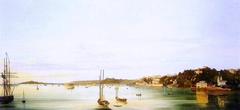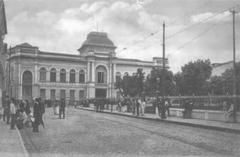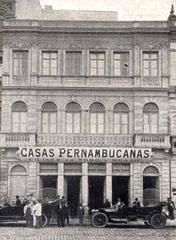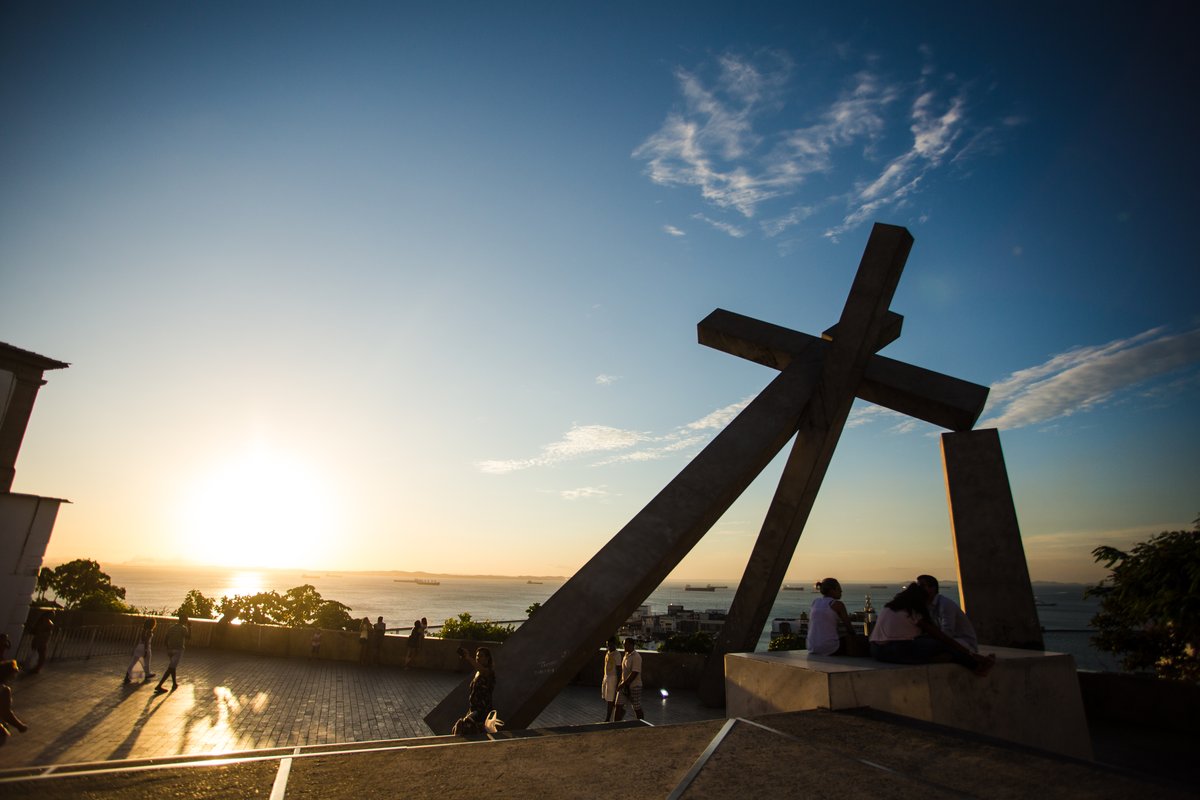
Cruz Caída Visiting Guide: Hours, Tickets, and Tips
Date: 16/08/2024
Introduction
The Monumento da Cruz Caída, or Fallen Cross Monument, in Salvador, Brazil, is a compelling landmark that encapsulates the city’s rich historical and cultural heritage. Designed by the acclaimed Bahian artist Mário Cravo, the monument was inaugurated in 1999 and stands as a tribute to the Igreja da Sé Primacial do Brasil, an old cathedral demolished in the 1930s to facilitate urban development (Tourb). Situated in the Praça da Cruz Caída, this 12-meter high contemporary sculpture blends modern art with elements of the baroque architectural style of the original church, symbolizing both the city’s colonial past and its vibrant present. Visitors to the Cruz Caída can immerse themselves in Salvador’s panoramic views, cultural events, and nearby historic sites, making it a must-visit destination for anyone looking to explore the depth and breadth of Salvador’s cultural landscape (London and the World).
Table of Contents
- Introduction
- History and Significance
- Visitor Information
- Role in Public Space and Community Events
- Proximity to Other Historical Sites
- Preservation and Urban Development
- Integration with Salvador’s Cultural Landscape
- FAQ
- Conclusion
History and Significance
Origins and Historical Context
The Monumento da Cruz Caída was created by the renowned Bahian artist Mário Cravo and is situated in the Praça da Cruz Caída, a prominent public square in Salvador’s historic center. The monument’s inception is deeply rooted in the history of the old Salvador Cathedral, known as the Igreja da Sé Primacial do Brasil, which was demolished in the 1930s to make way for tram tracks (Tourb).
Architectural and Artistic Significance
Standing at an impressive height of 12 meters, the Cruz Caída is a striking example of modern sculpture that incorporates elements of the baroque architectural style of the demolished cathedral. The design features large, cross-like structures that evoke the grandeur and monumental scale of the original church, serving as a critique of the loss of historical and cultural heritage due to urban development (Tourb).
Symbolism and Cultural Impact
The Fallen Cross Monument is a symbol of resistance and remembrance, testament to the cultural and religious significance of the original cathedral. Located with a panoramic view of the Baía de Todos os Santos (Bay of All Saints), it connects visitors to Salvador’s maritime and colonial past (London and the World).
Visitor Information
Visiting Hours and Tickets
The Cruz Caída is accessible at any time of day, although it is recommended to avoid visiting after 8 PM for safety reasons. There are no tickets required to visit the monument, making it an accessible destination for all visitors.
Travel Tips
The site is well-served by taxis and ride-sharing services, making it easy to reach from other parts of the city. Visitors can enjoy stunning views of the Baía de Todos os Santos, especially at sunset.
Role in Public Space and Community Events
The Praça da Cruz Caída functions as an open-air amphitheater and is a popular venue for various cultural and artistic events, including concerts and public performances. This multifunctional use underscores the monument’s role in contemporary Salvador as a living part of the city’s cultural fabric (Tourb).
Proximity to Other Historical Sites
The Cruz Caída is strategically located near several other significant landmarks in Salvador’s historic center. It is adjacent to the Museu da Misericórdia and the Memorial das Baianas de Acarajé, and within walking distance of the famous Pelourinho district and the Elevador Lacerda. This proximity makes it an integral part of any comprehensive tour of Salvador (Tourb).
Preservation and Urban Development
The creation of the Cruz Caída highlights the ongoing tension between urban development and historical preservation in Salvador. The demolition of the original cathedral for tram tracks in the 1930s is a reminder of the sacrifices often made in the name of progress. However, the establishment of the monument reflects a growing recognition of the importance of preserving cultural heritage (Revista DRCLAS).
Integration with Salvador’s Cultural Landscape
The Cruz Caída is more than just a monument; it is a vital part of Salvador’s cultural and historical narrative. It serves as a reminder of the city’s colonial past, its architectural heritage, and the ongoing efforts to balance preservation with modern urban needs. The monument’s role in public events and its proximity to other historical sites make it a key destination for anyone looking to understand the rich tapestry of Salvador’s history and culture (National Geographic).
FAQ
What are the visiting hours for Cruz Caída?
The monument is accessible at any time of day, though it is recommended to avoid visiting after 8 PM for safety reasons.
How much do tickets to Cruz Caída cost?
There are no tickets required to visit the Cruz Caída, making it free for all visitors.
What are some nearby attractions?
Nearby attractions include the Museu da Misericórdia, the Memorial das Baianas de Acarajé, the Pelourinho district, and the Elevador Lacerda.
Conclusion
The Monumento da Cruz Caída stands as a powerful symbol of Salvador’s historical and cultural heritage. Its creation by Mário Cravo and its location in the heart of the city’s historic center make it a must-visit site for anyone interested in Salvador’s rich history and vibrant culture. The monument not only commemorates the past but also serves as a dynamic part of the city’s present, hosting events and offering stunning views that connect visitors to the city’s maritime and colonial roots.
Ultimate Visitor Tips for Cruz Caída, Salvador: Best Times, Safety, and More
Best Time to Visit
Salvador, including Cruz Caída, is a year-round destination, but the best time to visit is from December to March. During these months, the weather is warm and sunny, with temperatures ranging from 25°C to 29°C, making it ideal for outdoor activities and exploring the city (Where and When). However, this period is also the high tourist season, so expect larger crowds and higher prices for accommodations and flights (Travellers Worldwide).
If you prefer a quieter experience, consider visiting between August and October. This off-season period offers mild temperatures and fewer tourists, allowing you to enjoy the attractions without the hassle of long lines and crowded spaces (Travellers Worldwide).
Safety Tips
Salvador is known for its vibrant culture and beautiful architecture, but it also has a reputation for being unsafe, especially for tourists. Here are some essential safety tips to keep in mind:
- Stay in Groups: Always stay in groups, especially at night. If you feel uncomfortable or unsafe, trust your instincts and move to a safer location (World Nomads).
- Be Discreet with Valuables: Avoid displaying expensive jewelry, electronics, or large amounts of cash. Use a cross-body sling bag to keep your belongings secure (Caroline Rose Travel).
- Use Taxis: Always take taxis at night, even if they are more expensive. Your safety is more important than your budget (World Nomads).
- Avoid Certain Areas: Stay away from the peripheries and poorer neighborhoods, which have higher crime rates. Stick to well-known tourist areas like Barra, Rio Vermelho, and Pelourinho (World Nomads).
Cultural Etiquette
Understanding local customs and etiquette can enhance your experience and help you connect with the local culture:
- Greetings: Brazilians are warm and friendly. A common greeting is a handshake or a kiss on the cheek, depending on the level of familiarity.
- Language: Portuguese is the official language. Learning a few basic phrases can go a long way in making your interactions smoother.
- Dress Code: Dress modestly when visiting religious sites. Beachwear is acceptable at the beach but not in the city or restaurants.
Local Cuisine
Salvador is famous for its Afro-Brazilian cuisine, which is a must-try for any visitor:
- Acarajé: A popular street food made from black-eyed peas, onions, and spices, deep-fried and served with shrimp and vatapá (a spicy paste made from bread, shrimp, coconut milk, and peanuts).
- Moqueca: A traditional fish stew made with coconut milk, tomatoes, onions, and peppers, often served with rice and farofa (toasted manioc flour).
- Caipirinha: Brazil’s national cocktail, made with cachaça (a sugarcane spirit), lime, sugar, and ice.
Attractions Near Cruz Caída
While visiting Cruz Caída, make sure to explore other nearby attractions to get a full experience of Salvador:
- Pelourinho: The historic center of Salvador, known for its colonial architecture, vibrant colors, and lively atmosphere. It’s a UNESCO World Heritage site and a must-visit for history and culture enthusiasts (Brazil Travel Guide).
- Elevador Lacerda: This iconic elevator connects the lower city (Cidade Baixa) with the upper city (Cidade Alta) and offers stunning views of the Bay of All Saints.
- Mercado Modelo: A bustling market where you can buy local crafts, souvenirs, and traditional foods. It’s a great place to experience the local culture and pick up unique gifts.
Practical Information
- Tickets and Visiting Hours: Cruz Caída is open to visitors daily, but it is best to check for any specific visiting hours or ticket requirements on official websites or local tourism boards.
- Currency: The official currency is the Brazilian Real (BRL). Credit cards are widely accepted, but it’s a good idea to carry some cash for small purchases and tips.
- Electricity: The standard voltage is 127/220V, and the frequency is 60Hz. The power plugs and sockets are of type N.
- Health and Safety: Make sure to have travel insurance that covers medical expenses. Drink bottled water and avoid ice in drinks to prevent waterborne illnesses.
Transportation
Getting around Salvador is relatively easy, with various transportation options available:
- Public Transport: Buses are the most common form of public transport, but they can be crowded and less reliable. The metro system is limited but efficient for certain routes.
- Taxis and Ride-Sharing: Taxis are widely available, and ride-sharing apps like Uber are popular and convenient.
- Walking: Many of Salvador’s attractions are within walking distance of each other, especially in the historic center. However, be cautious and avoid walking alone at night.
Accommodation
Salvador offers a range of accommodation options to suit different budgets and preferences:
- Luxury Hotels: For a luxurious stay, consider hotels like the Fasano Salvador or the Fera Palace Hotel, both offering excellent amenities and prime locations.
- Mid-Range Hotels: Mid-range options like the Hotel Casa do Amarelindo and the Bahiacafé Hotel provide comfort and good value for money.
- Budget Hostels: For budget travelers, hostels like the Hostel Galeria 13 and the Hostel Barra offer affordable rates and a chance to meet fellow travelers.
Local Events and Festivals
Salvador is known for its vibrant festivals and events, which offer a unique glimpse into the local culture:
- Carnival: Salvador’s Carnival is one of the largest in the world, featuring parades, music, and dancing. It usually takes place in February or March (Where and When).
- Festa de Iemanjá: Celebrated on February 2nd, this festival honors Iemanjá, the goddess of the sea, with offerings and ceremonies at the beach.
- São João Festival: Held in June, this festival celebrates the harvest season with traditional music, dancing, and food.
FAQ
Q: What are the visiting hours for Cruz Caída?
A: Cruz Caída is typically open to visitors daily. However, it’s advisable to check the official website or local tourism boards for specific visiting hours and any ticket requirements.
Q: Is it safe to visit Salvador at night?
A: While Salvador has areas that are safe for tourists, it’s generally recommended to stay in groups and use taxis or ride-sharing services at night for added safety.
Q: What should I wear when visiting Salvador?
A: Dress modestly when visiting religious sites. Beachwear is acceptable at the beach but not in the city or restaurants.
Conclusion
Visiting Cruz Caída in Salvador, Brazil, offers a rich cultural experience filled with history, vibrant festivals, and delicious cuisine. By following these visitor tips, you can ensure a safe and memorable trip. Enjoy the beauty and culture of Salvador while staying mindful of your surroundings and respecting local customs. For more tips and updates, download the Audiala mobile app and follow us on social media.
References
- Tourb, 1999, Monumento da Cruz Caída
- London and the World, 2023, The Best Things to Do in Salvador de Bahia, Brazil
- National Geographic, 2023, Inside Guide: Salvador, Cradle of Brazil’s Afro-Brazilian Heritage

